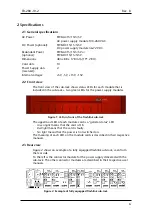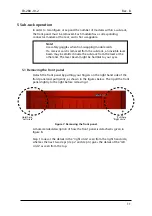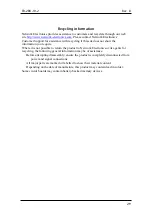
FR-2RU-10-2
Rev.
8
20
6
Fiber optics
The FR-2RU-10-2 may house fiber-optic equipment.
Even though a fiber-optic cable can look almost the same as an electrical wire,
special care must be taken. Inside the cable is a fiber made of glass. Glass has
very different physical properties than the copper used in electrical wires.
6.1
Handling of optical fibres
In practical terms this means that these precautions must be taken:
-
Do not bend the fiber too much
-
Do not put anything on top of the optical fiber.
-
Keep the connectors clean from dust
If a fiber is bent to much, parts of the transmitted light is lost.
We can compare light transmission through an optical fiber with driving a car
at maximum speed. We want the road to be as straight as possible. The
probability that your car is still on the road at the other end of the turn
decreases with increasing curvature of the turn. However, there is a major
difference. The transmitted light is gradually lost when the curvature
increases, while your car is either on the road, or not.
Therefore all the datasheets of optical fibres have a point called "minimum
bend radius" or something similar. This means that any bending of the fiber
corresponding to a bend radius less than the given value, will make the light
leak out of the fiber.
A typical value is 20 mm to 40 mm (Bellcore standard) for single mode fibres.
You should also avoid putting any heavy items on top of the optical fibres,
because this will change the optical properties of the fiber, and contribute to
errors in the transmitted signal.
Unless the fiber is damaged, it will regain its optical properties after a bend is
straightened out or the items are removed / the squeeze is released.
Note!
When patching at the rear of the sub-rack it is extremely
important that you don’t look directly into the fiber end.
If laser light is emitted this can destroy your eye. As a rule of
thumb:
Never look directly into a fiber end. This also applies inside
the sub-rack if a module is removed
.











































